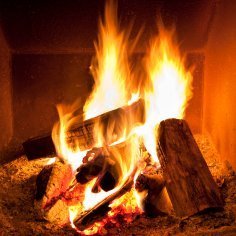
This page contains the following solutions.
It is getting to be that time of year and in some places already cold enough for that evening fire. So before this starts many people have their fireplaces checked to make sure the chimney is clear of all debris, animals (no joke, there are birds nest in many), and built up soot. I only wish I had a fire place now, but this is the first place of many that hasn't had one.
I recently read about the greatest inexpensive way of keeping it clear, no build up and it lasts if done forever. When you start your first fire, and every third one after that, put a handful of salt on top of the logs. Salt works to cut down on the black smoke. I do not believe everything I read; so of course I researched this and found many have known about it, heard of it, and some were reminded of it. I hope this can help some of you lucky people out.
A clean fire also means a warmer one which would help with heating. That is a plus for me. If I had a fireplace I would for sure do this. Many love using their fireplaces on a daily basis. I always did. My thing was cleaning up the next morning. I hate those black soot areas. The salt is suppose to help that, because the smoke flowing upwards is not blocked. Clean all the surrounding walls of the chimney.
If you have spots of black on your brick, I always used a brush and cleaning paste to get it off. You can use whatever you normally use to clean with on brick; it does not hurt it. I like natural, organic cleaning products because brick is porous. I would always use something you don't mind being in your lungs for years to come.
I always had a whisk broom with my fire place tools. I found the real use for it was cleaning whatever has dropped on the hearth before making it into the pit. It worked much better than those long handled, pretty ones do. It actually doesn't look bad just set it in front of all your pretty, more expensive fireplace tools. Make sure you keep your broom clean by washing it out weekly. I used to just put mine in a bucket of soapy water, and then let dry outside.
It may be a good time to save some wire hangers to use with your fires. Straighten several out for roasting marshmallows, hot dogs, etc. If you do it now they'll be ready for that first cold day to celebrate a new season.
Maybe these tips will help some of you out. If so, please pass them on. Happiness to everyone, I pray you all have many fun, warm memories ahead!
By Luana M. from San Diego, CA
One solution that I have found to remove creosote build-up is to throw all of your potato peels and available acorns directly into the fire. The potato peels can be collected and added whenever you have them. Acorns are abundant in autumn. Since I don't appreciate them all over my lawn, I rake them up into an old metal trash can. I add a handful or two a week. It beats spending $16 every month on the expensive store bought creosote buildup removers every month.
Please, don't forget that no matter what, a professional should clean your chimney either in the spring or before you start your first fire in the fall. :}
Source: A senior citizen friend that grew up on a farm in the 1930's.
By Pattie McIntyre from Bridgton
Here is a feedback to a request from a smart ThriftyFun guest back on 11/25/2007. I used this tip to clean my wood stove window. It was not only simple and thrifty, but fast!
"Simple, no cost. Take damp newspaper and dip in cold wood ashes. Rub on glass until creosote and film come off. Repeat as needed; finish with window cleaner. Works better than anything I buy."
If you have a wood-burning fireplace you need to have the chimney cleaned and inspected yearly. Also only burn fully dried hard woods to produce the most heat output.
Soot and dirt can stain the bricks on a fireplace, but there are ways to get them surprisingly clean. This is a page about cleaning fireplace bricks.